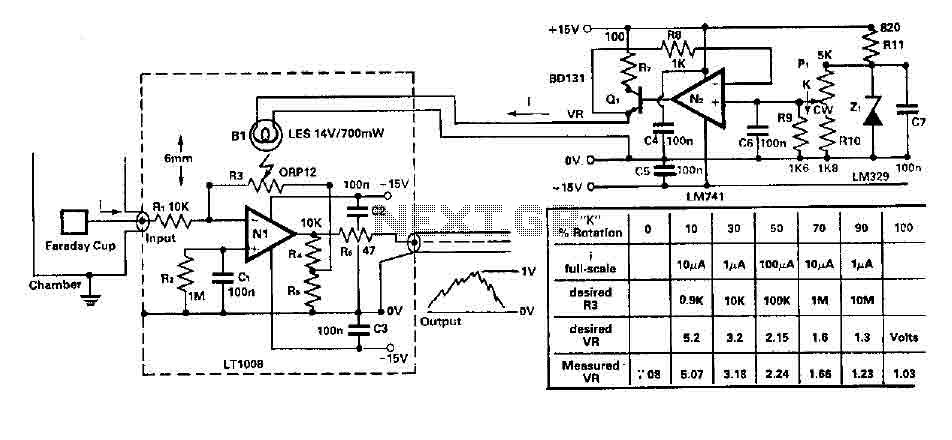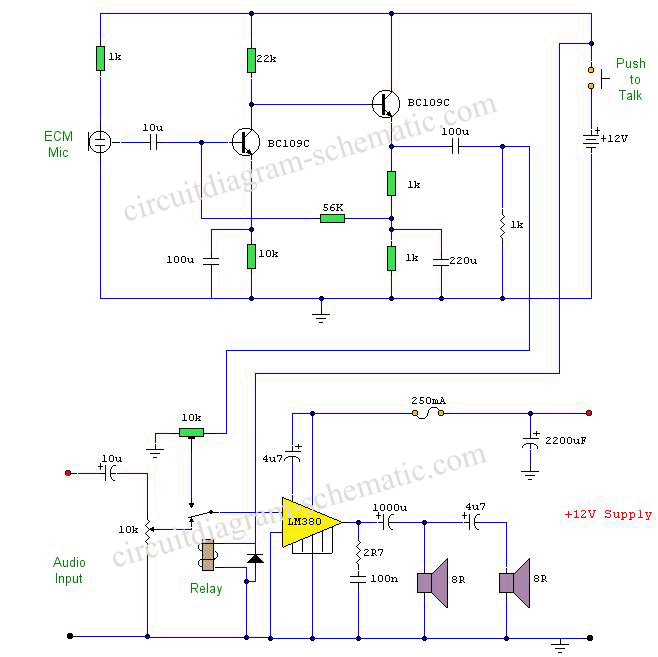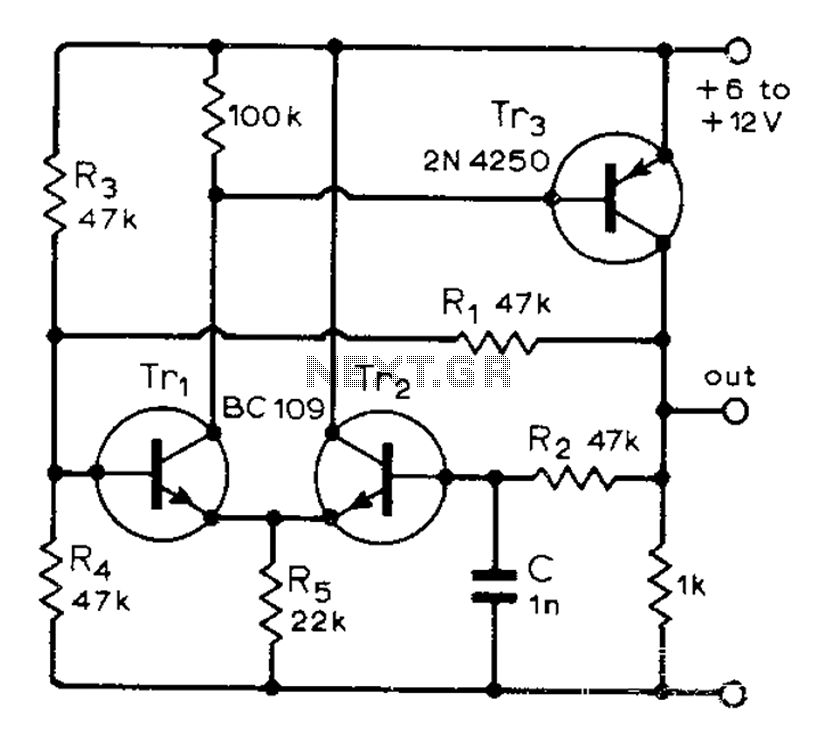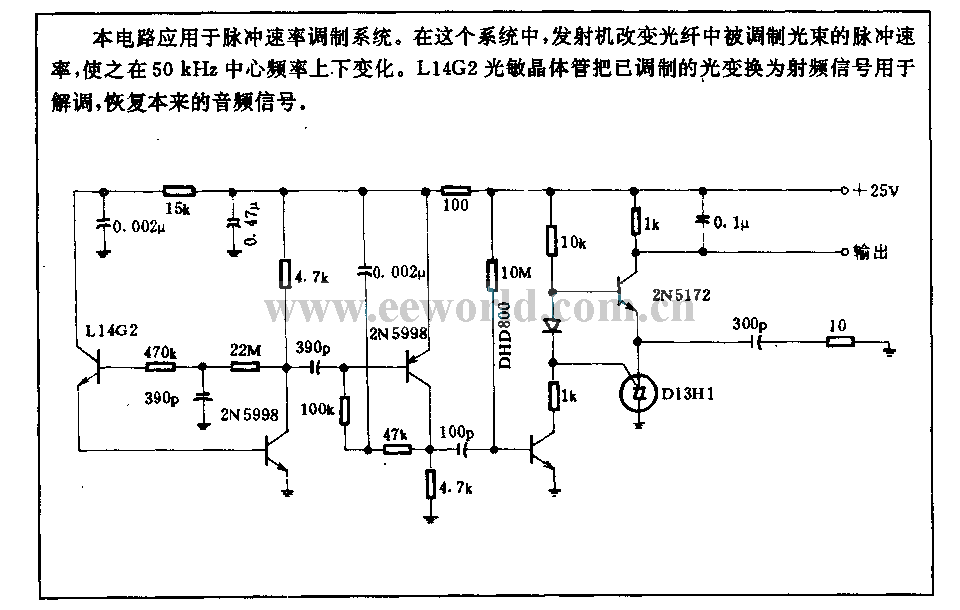
Fuse Saver Circuit

This circuit is particularly beneficial for hobbyists using a breadboard to experiment with ideas, as well as those employing a simple homemade DC power supply that consists of a transformer, rectifier, smoothing capacitor, and protective fuse, specifically one lacking overcurrent protection. The detecting element in this circuit is resistor R6. Under normal conditions, its voltage drop does not reach a level sufficient to activate transistor T1. The value of R6 can be adjusted to provide a different cutoff current, as determined by Ohm's Law, if necessary. When a short circuit occurs in the load, the voltage increases rapidly, causing T1 to conduct. This action energizes the relay, switching its contacts, which disconnects power from the external circuit and instead directly powers the relay coil, latching it in this second state. The circuit remains in this state until the primary power supply is turned off. Capacitors C1 and C2 retain sufficient charge (through diodes D3, D4, and D6, which prevent the charge from dissipating into the rest of the circuit, regardless of its state) to keep T1 activated and power the relay during the switching process, while resistors R2 and R4 provide slow discharge paths. LEDs D1 (red) and D5 (green) indicate the circuit's operational state. Inductor L1 limits the inrush current when the circuit is powered on, preventing immediate cutoff. Diodes D2 and D7 offer standard back-emf protection across the coils. The circuit’s input is connected to the main transformer-rectifier-capacitor-fuse power supply via K1, and the output is linked to the (experimental) load via K2. It is important to ensure that the input voltage is a floating supply if Vout is grounded through the load, as Vin and Vout must not be interconnected. Several components warrant careful consideration. Firstly, the choice of relay Re1 is crucial. For the prototype, a relay from Maplin, part number YX97F, was utilized. This relay has a coil resistance of 320 ohms, which, in conjunction with R1, forms the collector load for T1. Its specified pull-in voltage range is approximately 9 V to 19 V, thus limiting the input power supply voltage to a range of about 10 V to 30 V (DC only). R1 can be replaced with a wire link for operation at input voltages below 10 V or increased in value, based on Ohm's Law or through trial and error, for input voltages exceeding 30 V. The coil L1 was sourced from Farnell, part number 581-240. Additionally, the protective fuse for the input power supply should be of the slow-blow type, as fast fuses may rupture before the relay has time to activate. It is essential to note that this device is intended to protect fuses, not to replace them. A mains transformer must always be fused if it is not designed to operate safely, meaning it should not present a fire hazard, even if its output is subject to a continuous short-circuit fault.
The circuit design incorporates several critical elements that ensure its reliability and effectiveness in protecting the power supply from overcurrent situations. The resistor R6 serves as a vital sensing component, allowing for the customization of cutoff current levels based on the user's requirements. The transistor T1 acts as a switch, controlling the relay operation based on the voltage drop across R6. The relay's activation is crucial for disconnecting the load in the event of a fault, thereby safeguarding the power supply and the connected components.
The capacitors C1 and C2 play a significant role in maintaining circuit stability during the transition of states, ensuring that T1 remains activated long enough to allow the relay to switch without interruption. The inclusion of diodes D3, D4, and D6 is essential to prevent unwanted discharge paths, which could compromise the circuit's functionality.
LED indicators D1 and D5 provide visual feedback on the circuit's status, allowing users to quickly ascertain whether the circuit is in a normal operating condition or has entered a fault state. The inductor L1, by limiting the inrush current, enhances the durability of the circuit components during startup, reducing the risk of damage from sudden surges.
Overall, this circuit offers a robust solution for hobbyists and engineers seeking to protect their experimental setups from the dangers of overcurrent conditions. The careful selection of components, along with the thoughtful design of the circuit topology, ensures both functionality and safety in a variety of applications.This circuit will be particularly useful to those hobbyists who use a breadboard` to try out ideas and who also use a simple home-made` DC power supply consisting of a transformer, rectifier, smoothing capacitor and protective fuse, that is, one without over current protection! In this circuit, the detecting element is resistor R6. Under normal co nditions, its voltage drop is not high enough to switch on transistor T1. The value of R6 can be altered to give a different cut-off current, as determined by Ohm`s Law, if required. When a short circuit occurs in the load, the voltage rises rapidly and T1 starts to conduct. This draws in the relay, switching its contacts, which cuts off power to the external circuit, and instead powers the relay coil directly, latching it in this second state.
The circuit remains in this state until the primary power supply is switched off. Capacitors C1 and C2 hold enough charge (via D3, D4 and D6, which prevent the charge from being lost to the rest of the circuit, whichever state it is in) to keep T1 switched on and power the relay while it switches over, and R2 and R4 provide slow discharge paths. LEDs D1 (red) and D5 (green) indicate what state the circuit is in. Inductor L1 slows the inrush of current when the circuit is switched on, which would otherwise cut off the circuit immediately.
D2 and D7 provide the usual back-emf protection across the coils. In use, the input of the circuit is connected to the main transformer-rectifier-capacitor-fuse power supply via K1, and the output is connected to the (experimental) load via K2. Note that the input voltage must be a floating supply if Vout is grounded via the load, as Vin and Vout must not be connected together.
Some consideration needs to be given to a number of components. First, the choice of relay Re1. For the prototype, this was obtained from Maplin, part number YX97F. This is has a coil resistance of 320, which with R1 forms the collector load for T1. Its allowed pull-in voltage range is nominally 9 V to 19 V, which limits the input power supply voltage to between around 10 V to 30 V (DC only). R1 could be replaced by a wire link for operation at input voltages below 10 V, or increased in value, as determined by either the application of Ohm`s Law once more or trial and error, for an input voltage above 30 V.
Coil L1 was obtained from Farnell, part number 581-240. Finally, the protective fuse for the input power supply should be a slow-blow` type; fast` fuses will rupture before the relay has time to switch. Also note that this device is meant to save fuses, not replace them. A mains transformer must always be fused if it is not designed to run safely, i. e. , without presenting a fire hazard, even if its output has a continuous short-circuit fault. 🔗 External reference
The circuit design incorporates several critical elements that ensure its reliability and effectiveness in protecting the power supply from overcurrent situations. The resistor R6 serves as a vital sensing component, allowing for the customization of cutoff current levels based on the user's requirements. The transistor T1 acts as a switch, controlling the relay operation based on the voltage drop across R6. The relay's activation is crucial for disconnecting the load in the event of a fault, thereby safeguarding the power supply and the connected components.
The capacitors C1 and C2 play a significant role in maintaining circuit stability during the transition of states, ensuring that T1 remains activated long enough to allow the relay to switch without interruption. The inclusion of diodes D3, D4, and D6 is essential to prevent unwanted discharge paths, which could compromise the circuit's functionality.
LED indicators D1 and D5 provide visual feedback on the circuit's status, allowing users to quickly ascertain whether the circuit is in a normal operating condition or has entered a fault state. The inductor L1, by limiting the inrush current, enhances the durability of the circuit components during startup, reducing the risk of damage from sudden surges.
Overall, this circuit offers a robust solution for hobbyists and engineers seeking to protect their experimental setups from the dangers of overcurrent conditions. The careful selection of components, along with the thoughtful design of the circuit topology, ensures both functionality and safety in a variety of applications.This circuit will be particularly useful to those hobbyists who use a breadboard` to try out ideas and who also use a simple home-made` DC power supply consisting of a transformer, rectifier, smoothing capacitor and protective fuse, that is, one without over current protection! In this circuit, the detecting element is resistor R6. Under normal co nditions, its voltage drop is not high enough to switch on transistor T1. The value of R6 can be altered to give a different cut-off current, as determined by Ohm`s Law, if required. When a short circuit occurs in the load, the voltage rises rapidly and T1 starts to conduct. This draws in the relay, switching its contacts, which cuts off power to the external circuit, and instead powers the relay coil directly, latching it in this second state.
The circuit remains in this state until the primary power supply is switched off. Capacitors C1 and C2 hold enough charge (via D3, D4 and D6, which prevent the charge from being lost to the rest of the circuit, whichever state it is in) to keep T1 switched on and power the relay while it switches over, and R2 and R4 provide slow discharge paths. LEDs D1 (red) and D5 (green) indicate what state the circuit is in. Inductor L1 slows the inrush of current when the circuit is switched on, which would otherwise cut off the circuit immediately.
D2 and D7 provide the usual back-emf protection across the coils. In use, the input of the circuit is connected to the main transformer-rectifier-capacitor-fuse power supply via K1, and the output is connected to the (experimental) load via K2. Note that the input voltage must be a floating supply if Vout is grounded via the load, as Vin and Vout must not be connected together.
Some consideration needs to be given to a number of components. First, the choice of relay Re1. For the prototype, this was obtained from Maplin, part number YX97F. This is has a coil resistance of 320, which with R1 forms the collector load for T1. Its allowed pull-in voltage range is nominally 9 V to 19 V, which limits the input power supply voltage to between around 10 V to 30 V (DC only). R1 could be replaced by a wire link for operation at input voltages below 10 V, or increased in value, as determined by either the application of Ohm`s Law once more or trial and error, for an input voltage above 30 V.
Coil L1 was obtained from Farnell, part number 581-240. Finally, the protective fuse for the input power supply should be a slow-blow` type; fast` fuses will rupture before the relay has time to switch. Also note that this device is meant to save fuses, not replace them. A mains transformer must always be fused if it is not designed to run safely, i. e. , without presenting a fire hazard, even if its output has a continuous short-circuit fault. 🔗 External reference





